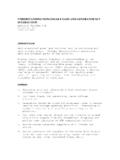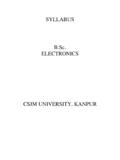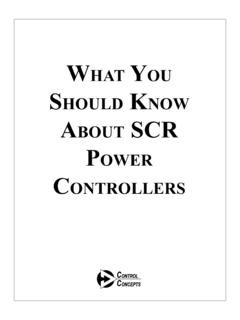Transcription of Photodiode/Phototransistor Application Circuit
1 Application Note 1 Application NoteOptoelectronicsFUNDAMENTAL photodiode CIRCUITSF igures 1 and 2 show the fundamental Circuit shown in Figure 1 transforms a photo-current produced by a photodiode without bias into avoltage. The output voltage (VOUT) is given asVOUT=1P RL. It is more or less proportional to theamount of incident light when VOUT < VOC. It can alsobe compressed logarithmically relative to the amount ofincident light when VOUT is near VOC. (VOC is the open-terminal voltage of a photodiode ).Figure 1 (B) shows the operating point for a load resis-tor (RL) without Application of bias to the 2 shows a Circuit in which the photodiode isreverse-biased by VCC and a photocurrent (IP) is trans-formed into an output voltage.
2 Also in this arrangement,the VOUT is given as VOUT = IP RL. An output voltageproportional to the amount of incident light is proportional region is expanded by the amount ofVCC {proportional region: VOUT < (VOC + VCC)}. On theother hand, Application of reverse bias to the photo-diode causes the dark current (Id) to increase, leavinga voltage of Id RL when the light is interrupted, andthis point should be noted in designing the 2 (B) shows the operating point for a loadresistor RL with reverse bias applied to the of a Circuit used with a reverse-biased pho-todiode are: High-speed response Wide-proportional-range of outputTherefore, this Circuit is generally 1.
3 Fundamental Circuit of photodiode (Without Bias)Figure 2. Fundamental Circuit of photodiode (With Bias)VOUTIPRLEVOP1-16 VOUTRLEV1EV2EV3EV1< EV2< EV3IV(A)(B)IPOP1-17 VCCRLVOUTVOUTRLEV1EV2EV3EV1< EV2< EV3 IVVCC(A)(B)EVPhotodiode/ phototransistor Application CircuitOptoelectronicsPhotodiode/Phototr ansistor ..2 Application NoteThe response time is inversely proportional to thereverse bias voltage and is expressed as follows:r = Cj RLCj: junction capacitance of the photodiodeRL: load resistorVD: diffusion potential ( V - V)VR: Reverse bias voltage (negative value)n: 2 - 3 PHOTOCURRENT AMPLIFIER Circuit USING THE TRANSISTOR OF PHOTODIODEF igures 3 and 4 show photocurrent amplifiers Circuit shown in Figure 3 are most basic combina-tions of a photodiode and an amplifying transistor.
4 In thearrangement of Figure 3 (A), the photocurrent producedby the photodiode causes the transistor (Tr1) to decreaseits output (VOUT) from high to low. In the arrangement ofFigure 3 (B), the photocurrent causes the VOUT toincrease from low to high. Resistor RBE in the Circuit iseffective for suppressing the influence of dard current (Id)and is chosen to meet the following conditions:RBE < VBD/IdRBE > VBE/{IP - VCC/(RL hFE)} Figure 4 shows simple amplifiers utilizing the Circuit of Figure 4 (A), the output (VOUT) isgiven as:VOUT = IP R1 + IB R1 + VBEThis arrangement provides a large output and rela-tively fast Circuit of Figure 4 (B) has an additional transis-tor (Tr2) to provide a larger output ()=1n--- Figure 3.
5 Photocurrent Amplifier Circuit using TransistorIPOP1-18 RBEVCCTr1 RLTr1 RBEVOUTVBEVBERLVCCVOUTIP(A)(B)Figure 4. Photocurrent Amplifier Circuit with Negative FeedbackTr1R1R3 VCCR2 VOUTTr2Tr1R1R2 VCCVOUTVBEIPOP1-19(A)(B)IBPhotodiode/Pho totransistor ..OptoelectronicsApplication Note3 AMPLIFIER Circuit USING OPERATIONAL AMPLIFIERF igure 6 shows a photocurrent-voltage conversioncircuit using an operational amplifier. The output volt-age (VOUT) is given as VOUT = IF R1 (IP ISC). Thearrangement utilizes the characteristics of an opera-tional amplifier with two input terminals at about zerovoltage to operate the photodiode without bias. The cir-cuit provides an ideal short- Circuit current (ISC) in awide operating 6 (B) shows the output voltage vs.
6 Radiantintensity characteristics. An arrangement with no biasand high impedance loading to the photodiode pro-vides the following features: Less influence by dark current Wide linear range of the photocurrent relative to theradiant 5 shows a logarithmic photocurrent amplifierusing an operating amplifier. The Circuit uses a logarith-mic diode for the logarithmic conversion of photocur-rent into an output voltage. In dealing with a very wideirradiation intensity range, linear amplification results ina saturation of output because of the limited linearregion of the operational amplifier, whereas logarithmiccompression of the photocurrent prevents the satura-tion of output.
7 With its wide measurement range, thelogarithmic photocurrent amplifier is used for the expo-sure meter of 5. Logarithmic Photocurrent Amplifier using an Operational AmplifierVCCVOUT+OPAMP+VCCOP1-21 LOG-DIODE (IS002)Figure 6. Photocurrent Amplifier using an Operational Amplifier (Without Bias)R1 VCCVOUT(A)+OPAMP+VCCIPVOUTEV(B)(IP ISC) IP . R1OP1-20 OptoelectronicsPhotodiode/Phototransisto r ..4 Application NoteLIGHT DETECTING Circuit FOR MODULATED LIGHT INPUTF igure 7 shows a light detecting Circuit which usesan optical remote control to operate a television set, airconditioner, or other devices. Usually, the opticalremote control is used in the sunlight or the illuminationof a fluorescent lamp.
8 To alleviate the influence of sucha disturbing light, the Circuit deals with pulse-modula-tion Circuit shown in Figure 7 detects the light inputby differentiating the rising and falling edges of a pulsesignal. To amplify a very small input signal, an FET pro-viding a high input impedance is SENSOR AMPLIFIER CIRCUITF igure 8 shows a color sensor amplifier using asemiconductor color sensor. Two short Circuit currents(ISC1, ISC2) conducted by two photodiodes having dif-ferent spectral sensitivities are compressed logarithmi-cally and applied to a subtraction Circuit whichproduces a differential output (VOUT). The output volt-age (VOUT) is formulated as follows:Where A is the gain of the differential amplifier.
9 Thegain becomes A = R2/R1 when R1 = R3 and R2 = R4, then:The output signal of the semiconductor color sensoris extremely low level. Therefore, great care must betaken in dealing with the signal. For example, low-biased, low-drift operational amplifiers must be used,and possible current leaks of the surface of be taken into ISC2 ISC1----------- A =Figure 7. Light Detecting Circuit for Modulated Light Input PIN PhotodiodeVOUTkTq-------log ISC2 ISC1----------- R2R1------- =VOUTR1OP1-22 PINPHOTODIODER2R3C4C3C1 VCCC2R5++R4Tr1 Figure 8. Color Sensor Amplifier Circuit +OPAMP+OPAMP+VCCVOUT+OPAMP-VCCD1 (LOG-DIODE)C1C2R2R3R4D2 (LOG-DIODE)OP1-23 ISC1 ISC2+VCC-VCCR1+VCC-VCCP hotodiode/ phototransistor .
10 OptoelectronicsApplication Note5 FUNDAMENTAL phototransistor CIRCUITSF igures 9 and 10 show the fundamental phototrans-istor circuits. The Circuit shown in Figure 9 (A) is a com-mon-emitter amplifier. Light input at the base causesthe output (VOUT) to decrease from high to low. The cir-cuit shown in Figure 9 (B) is a common-collector ampli-fier with an output (VOUT) increasing from low to high inresponse to light input. For the circuits in Figure 9 tooperate in the switching mode, the load resistor (RL)should be set in relation with the collector current (IC)as VCC < RL Circuit shown Figure 10 (A) uses a phototrans-istor with a base terminal. A RBE resistor connectedbetween the base and emitter alleviates the influenceof a dark current when operating at a high Circuit shown in Figure 10 (B) features a cascadeconnection of the grounded-base transistor (Tr1) sothat the phototransistor is virtually less loaded, therebyimproving the Circuit USING TRANSISTORF igure 11 shows the transistor amplifiers used toamplify the collector current of the phototransistorusing a transistor (Tr1).






